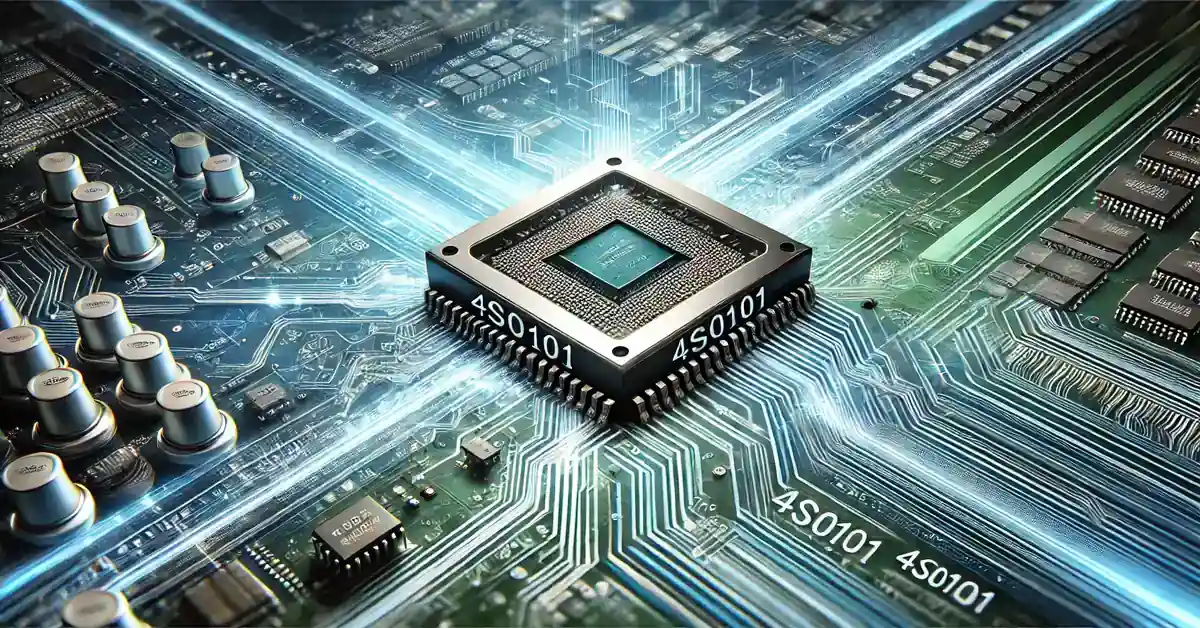The 4S0101 chip is a versatile and essential component widely used in various electronic devices and systems. Known for its efficiency, reliability, and multifunctional capabilities, the 4S0101 IC plays a critical role in enabling numerous functionalities across different types of circuits. As the electronics industry continues to advance, the 4S0101 chip has gained significant popularity due to its adaptability and capability to meet the increasing demands of modern technology.
In this article, we’ll explore the structure, functions, applications, and benefits of the 4S0101 chip, as well as its importance in today’s rapidly advancing technological landscape. We’ll also delve into why the 4S0101 IC has become a preferred choice for electronic designers and manufacturers alike.
What is the 4S0101 Chip?
The 4S0101 chip is an integrated circuit (IC) designed to handle multiple tasks in electronic devices. An integrated circuit is a miniaturized electronic circuit that incorporates multiple components, such as transistors, capacitors, and resistors, all integrated onto a single piece of semiconductor material—typically silicon. The 4S0101 IC manages and controls electrical signals within a device, allowing it to process data, execute instructions rapidly, and handle complex tasks efficiently.
Due to its adaptability, the 4S0101 chip is used in a variety of applications, making it a key component in consumer electronics, industrial systems, and communication devices. Its ability to handle a range of different functions makes it an essential part of modern technology, providing solutions for applications that require fast response times, reliable performance, and data processing.
Structure of the 4S0101 Chip
The internal structure of the 4S0101 chip consists of several electronic components working together to execute its various functions. These components include:
1. Transistors
Transistors are the building blocks of any integrated circuit. They act as switches or amplifiers that help manage electrical signals within the chip. The 4S0101 IC incorporates multiple transistors that work together to process data and control electrical flow, allowing it to execute instructions quickly and accurately.
2. Capacitors
Capacitors store and release electrical energy as needed. In the 4S0101 chip, capacitors help maintain the stability of the electrical signals and reduce noise, which ensures smooth functioning of the device.
3. Resistors
Resistors control the flow of electrical current through the 4S0101 chip. They help maintain appropriate voltage levels, ensuring that each component within the IC functions properly without being overloaded.
These components are arranged in a compact design to minimize size while maximizing efficiency. This efficient design allows the 4S0101 chip to manage multiple functions while maintaining reliable performance, making it suitable for a wide range of applications.
Functions of the 4S0101 Chip
The 4S0101 chip operates as an integrated circuit that manages and controls electrical signals within a device. It is capable of handling complex data processing tasks and executing instructions rapidly. This is crucial for devices that require fast response times and reliable performance. Some of the key functions of the 4S0101 IC include:
1. Signal Amplification
The 4S0101 chip is often used to amplify electrical signals within a device. This means that it can take a weak electrical signal and increase its strength, making it suitable for further processing. Signal amplification is essential in communication devices, where signals need to be strong enough to travel over long distances.
2. Data Processing
Data processing is another key function of the 4S0101 chip. It can handle large amounts of data, process it, and execute instructions based on that data. This capability is essential in microcontrollers and other computing devices where data needs to be processed quickly and efficiently.
3. Signal Control and Routing
The 4S0101 chip also manages signal control and routing within a circuit. It directs electrical signals to the appropriate components within the device, ensuring that each part of the system receives the necessary input to function properly.
4. Voltage Regulation
Voltage regulation is an important function of the 4S0101 chip, as it ensures that all components within a device receive the correct voltage level. This helps to prevent damage to sensitive components and ensures reliable operation.
Applications of the 4S0101 Chip
The 4S0101 chip is used in a wide range of applications due to its versatility and reliability. Its ability to handle multiple functions, along with its efficient design, makes it suitable for use in various electronic devices and systems. Here’s a closer look at some of the common applications:
1. Consumer Electronics
One of the primary applications of the 4S0101 chip is in consumer electronics. Devices such as smartphones, tablets, and laptops rely on integrated circuits like the 4S0101 IC to manage data processing, signal control, and power regulation. Its compact size and ability to handle multiple tasks make it ideal for use in these compact electronic devices.
- Smartphones and Tablets: The 4S0101 chip is used to manage signal processing and data handling, ensuring smooth operation of the device.
- Wearable Devices: In wearable electronics, such as smartwatches and fitness trackers, the 4S0101 IC is used to regulate power and process data from sensors, providing users with real-time information.
2. Communication Devices
The 4S0101 chip is also widely used in communication devices, where its ability to amplify and control signals is particularly valuable. In devices such as routers, modems, and transceivers, the 4S0101 IC helps manage data transmission and ensures that signals are properly processed and transmitted.
- Routers and Modems: In networking equipment, the 4S0101 chip is used to process incoming and outgoing data, ensuring efficient communication between devices.
- Radio Communication: The chip’s ability to amplify signals makes it suitable for use in radio communication devices, where clear and strong signal transmission is essential.
3. Industrial Control Systems
In industrial control systems, the 4S0101 chip is used to manage the control and regulation of machinery and equipment. It is often used in PLC (Programmable Logic Controller) systems, where it helps manage the flow of data between different components, ensuring that machinery operates efficiently and safely.
- Automation Systems: The 4S0101 chip plays a key role in automated manufacturing processes, where it helps control the movement of machinery, manage sensor data, and ensure that all components work in harmony.
- Power Regulation: In industrial environments, the 4S0101 IC helps regulate power to ensure that equipment receives the correct voltage levels, reducing the risk of damage and improving overall system reliability.
4. Automotive Electronics
In the automotive industry, the 4S0101 chip is used in various electronic control units (ECUs) to manage systems such as engine control, braking, and infotainment. Its ability to handle multiple functions makes it ideal for managing the complex electrical systems found in modern vehicles.
- Engine Control Units: The 4S0101 IC is used to process data from various sensors and control the engine’s performance, optimizing fuel efficiency and reducing emissions.
- Infotainment Systems: In infotainment systems, the chip helps manage audio and video signals, ensuring high-quality output for the driver and passengers.
5. Power Management Systems
The 4S0101 chip is also used in power management systems, where it helps regulate power distribution, monitor voltage levels, and ensure that all components within a system receive the correct power supply. This is essential in devices that require stable power to function properly, such as renewable energy systems and backup power supplies.
- Solar Inverters: In solar power systems, the 4S0101 IC helps regulate the power generated by solar panels, ensuring that it is properly distributed and used efficiently.
- UPS (Uninterruptible Power Supply): In UPS systems, the chip monitors voltage levels and helps switch between different power sources to ensure continuous power supply during outages.
Benefits of Using the 4S0101 Chip
The 4S0101 chip offers several advantages that make it a preferred choice for electronic designers and manufacturers. Here are some of the key benefits:
1. Versatility
One of the main advantages of the 4S0101 IC is its versatility. It can be used in a wide range of applications, from consumer electronics to industrial control systems, making it an essential component in various devices. Its ability to handle multiple functions, including signal amplification, data processing, and voltage regulation, makes it suitable for use in different environments.
2. Compact Design
The compact design of the 4S0101 chip allows it to be easily integrated into small devices, such as wearables and smartphones. Despite its small size, it is capable of handling complex tasks, making it ideal for use in devices where space is limited.
3. Efficiency
The 4S0101 IC is known for its efficiency. It is designed to handle data processing and signal control tasks without consuming excessive power, making it an energy-efficient choice for devices that require long battery life.
4. Reliability
The 4S0101 chip is highly reliable, making it suitable for use in critical applications, such as automotive control systems and industrial automation. Its robust design ensures that it can operate in challenging environments and provide consistent performance.
5. Cost-Effectiveness
The 4S0101 IC is also cost-effective, making it a popular choice for manufacturers looking to develop high-quality devices without incurring high costs. Its versatility and efficiency allow it to be used in multiple applications, reducing the need for additional components and simplifying the overall design.
Challenges and Considerations
While the 4S0101 chip offers numerous benefits, there are also some challenges and considerations that need to be addressed:
1. Complex Design Requirements
The 4S0101 IC is a sophisticated component, and integrating it into a device may require advanced knowledge of circuit design. Proper design and implementation are essential to ensure that the chip functions as intended.
2. Thermal Management
Like other integrated circuits, the 4S0101 chip generates heat during operation. Proper thermal management is essential to prevent overheating and ensure the chip’s longevity and reliability.
Conclusion
The 4S0101 chip is a versatile and powerful component that plays a critical role in modern electronics. Its ability to handle multiple functions, including signal amplification, data processing, and voltage regulation, makes it an indispensable part of various devices and systems. From consumer electronics and communication devices to industrial control systems and automotive electronics, the 4S0101 IC has proven its value across a wide range of applications.
With its efficiency, reliability, and compact design, the 4S0101 chip has become a preferred choice for electronic designers and manufacturers seeking to develop high-quality devices. As technology continues to evolve, the demand for versatile and efficient components like the 4S0101 IC is only expected to grow, further solidifying its position in the electronics industry.
FAQs About the 4S0101 Chip
1. What is the 4S0101 chip used for?
The 4S0101 chip is used in various electronic devices for signal amplification, data processing, and voltage regulation. Its versatility makes it suitable for use in consumer electronics, communication devices, industrial systems, and automotive electronics.
2. What are the key functions of the 4S0101 chip?
The 4S0101 IC performs multiple functions, including signal amplification, data processing, signal control, and voltage regulation. These functions help manage electrical signals, control data flow, and ensure reliable performance in different devices.
3. Why is the 4S0101 chip popular in the electronics industry?
The 4S0101 chip is popular due to its versatility, efficiency, compact design, and reliability. It can handle a wide range of functions, making it suitable for various applications, and it provides consistent performance in different environments.
4. What industries use the 4S0101 chip?
The 4S0101 chip is used in multiple industries, including consumer electronics, communication, industrial automation, and automotive. It helps manage data processing, signal control, and power regulation in these sectors.
5. How does the 4S0101 chip improve device performance?
The 4S0101 chip improves device performance by efficiently managing data processing, controlling signal flow, and regulating voltage. This ensures reliable and smooth operation, reduces energy consumption, and enhances the overall functionality of the device.
6. Are there any challenges associated with using the 4S0101 chip?
Some challenges associated with the 4S0101 chip include complex design requirements and the need for proper thermal management to prevent overheating. Ensuring proper integration and design is essential for optimal performance.





